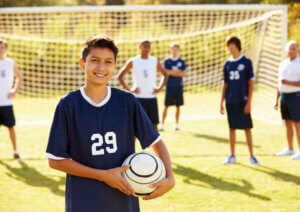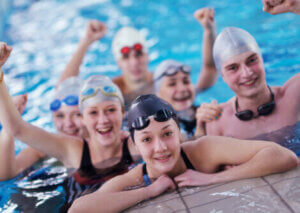4 Tips to Motivate Teens to Exercise

For coaches, it can be hard to motivate teens to exercise. This transitional stage between childhood and adulthood has some unique traits, and it’s important to pay attention to them.
Adolescence can be very complicated and requires special skills to know how to manage it. Among those skills, patience and empathy stand out. In other words, you need to understand their problems from their perspective without belittling them. As trivial as they may seem, problems mean a lot to teenagers.
On the other hand, one of the characteristics of this stage is a feeling of apathy and lack of motivation. This is due to the fact that their identity is changing constantly. Sometimes, feeling as if you don’t fit in can cause negative emotions.
Coaches have to be vigilant to keep teens motivated and boost athletic performance. Also, if you know how to motivate teens to exercise, you’ll gain a lot of ground. Next, we’ll take a look at some tips that might help you.
Motivate teens to exercise: reinforcements are effective
Everyone, regardless of age, needs reinforcements to stay motivated. Also, to be effective, the reinforcements have to be meaningful and attractive to the person.
Choosing effective reinforcements isn’t an easy task since you have to know the person. Regarding this, you must know that not all reinforcements work for everyone. Therefore, make sure the rewards do their job: maintain or increase the frequency of a behavior.
Social reinforcement, such as gestures of affection or congratulations, usually works very well for most people. Who doesn’t like that their trainer recognizes their effort, or that they performed a difficult skill well?

Explain the short-term consequences
Teens have a hard time with long-term planning, compared to most adults. This is because the prefrontal cortex, the area in charge of these tasks, isn’t fully mature. In fact, it’s estimated that this region doesn’t become fully developed until approximately 25 years of age.
This means that to motivate teens to exercise, it’s best to explain the short-term consequences that training will have on their health and performance. If they understand that they’re getting immediate benefits, it’ll be easier for them to complete training exercises.
For example, for a teenager to commit and get into the habit of stretching after training, it’s best to explain how stretching affects them over the next few hours. In this way, they’ll see that they’ll feel more relaxed and will be less sore the next day.
Motivate teens to exercise: regulate negative emotions
In difficult times, it’s normal for negative emotions and self-doubt to appear. However, you can’t live with resignation and wait for them to pass on their own. You have to take certain actions.
For teenagers, pay special attention to how they handle negative emotions because, in general, they have no control over them. In the face of any mistake, it’s common for teens to react with anger or frustration, whereas adults might let it go and not think about it.
Coaches have to teach their athletes emotional management techniques so they can apply them when they have to. Relaxation techniques is a great starting point.
Progressively increase autonomy in tasks
Teenagers can’t stand being treated like children. They see themselves as competent adults in all tasks and will try to carry them out themselves, even if they don’t have all the necessary skills.

This means that if a coach treats them in a paternalistic way, teens will act defensively. On the other hand, they can’t be left totally free and unsupervised. So, a solution would be to put in place what’s known in psychology as scaffolding.
Scaffolding consists of leaving a certain degree of autonomy depending on the abilities of the adolescent. That is, adjust the supervision by the coach to the capabilities and resources of the athlete. The more skills the adolescent has, the less the coach needs to monitor him. Therefore, the more autonomy the teen can have.
To motivate teens to exercise, think like them
Although physically there isn’t much difference between adolescents and adults, the truth is that on a mental level, there’s a huge gap between both stages. It’s a mistake to interpret the behaviors of teenagers from the perspective of a mature adult.
Adolescence can be a troubling time, but it also has its virtues. Young people have more vitality and curiosity than adults. All this is added to a nonconformist spirit that pushes them to look for new alternatives, which can be a promising combination.
For coaches, it can be hard to motivate teens to exercise. This transitional stage between childhood and adulthood has some unique traits, and it’s important to pay attention to them.
Adolescence can be very complicated and requires special skills to know how to manage it. Among those skills, patience and empathy stand out. In other words, you need to understand their problems from their perspective without belittling them. As trivial as they may seem, problems mean a lot to teenagers.
On the other hand, one of the characteristics of this stage is a feeling of apathy and lack of motivation. This is due to the fact that their identity is changing constantly. Sometimes, feeling as if you don’t fit in can cause negative emotions.
Coaches have to be vigilant to keep teens motivated and boost athletic performance. Also, if you know how to motivate teens to exercise, you’ll gain a lot of ground. Next, we’ll take a look at some tips that might help you.
Motivate teens to exercise: reinforcements are effective
Everyone, regardless of age, needs reinforcements to stay motivated. Also, to be effective, the reinforcements have to be meaningful and attractive to the person.
Choosing effective reinforcements isn’t an easy task since you have to know the person. Regarding this, you must know that not all reinforcements work for everyone. Therefore, make sure the rewards do their job: maintain or increase the frequency of a behavior.
Social reinforcement, such as gestures of affection or congratulations, usually works very well for most people. Who doesn’t like that their trainer recognizes their effort, or that they performed a difficult skill well?

Explain the short-term consequences
Teens have a hard time with long-term planning, compared to most adults. This is because the prefrontal cortex, the area in charge of these tasks, isn’t fully mature. In fact, it’s estimated that this region doesn’t become fully developed until approximately 25 years of age.
This means that to motivate teens to exercise, it’s best to explain the short-term consequences that training will have on their health and performance. If they understand that they’re getting immediate benefits, it’ll be easier for them to complete training exercises.
For example, for a teenager to commit and get into the habit of stretching after training, it’s best to explain how stretching affects them over the next few hours. In this way, they’ll see that they’ll feel more relaxed and will be less sore the next day.
Motivate teens to exercise: regulate negative emotions
In difficult times, it’s normal for negative emotions and self-doubt to appear. However, you can’t live with resignation and wait for them to pass on their own. You have to take certain actions.
For teenagers, pay special attention to how they handle negative emotions because, in general, they have no control over them. In the face of any mistake, it’s common for teens to react with anger or frustration, whereas adults might let it go and not think about it.
Coaches have to teach their athletes emotional management techniques so they can apply them when they have to. Relaxation techniques is a great starting point.
Progressively increase autonomy in tasks
Teenagers can’t stand being treated like children. They see themselves as competent adults in all tasks and will try to carry them out themselves, even if they don’t have all the necessary skills.

This means that if a coach treats them in a paternalistic way, teens will act defensively. On the other hand, they can’t be left totally free and unsupervised. So, a solution would be to put in place what’s known in psychology as scaffolding.
Scaffolding consists of leaving a certain degree of autonomy depending on the abilities of the adolescent. That is, adjust the supervision by the coach to the capabilities and resources of the athlete. The more skills the adolescent has, the less the coach needs to monitor him. Therefore, the more autonomy the teen can have.
To motivate teens to exercise, think like them
Although physically there isn’t much difference between adolescents and adults, the truth is that on a mental level, there’s a huge gap between both stages. It’s a mistake to interpret the behaviors of teenagers from the perspective of a mature adult.
Adolescence can be a troubling time, but it also has its virtues. Young people have more vitality and curiosity than adults. All this is added to a nonconformist spirit that pushes them to look for new alternatives, which can be a promising combination.
All cited sources were thoroughly reviewed by our team to ensure their quality, reliability, currency, and validity. The bibliography of this article was considered reliable and of academic or scientific accuracy.
- Helen Jõesaar, Vello Hein, Martin S. Hagger. 2011. Peer influence on young athletes’ need satisfaction, intrinsic motivation and persistence in sport: A 12-month prospective study.
Psychology of Sport and Exercise. https://doi.org/10.1016/j.psychsport.2011.04.005.
(http://www.sciencedirect.com/science/article/pii/S1469029211000537) - Cantalejo, C. R. (2010). La motivación y la ansiedad en la práctica deportiva en jóvenes. Innovación y experiencias educativas, 3.
This text is provided for informational purposes only and does not replace consultation with a professional. If in doubt, consult your specialist.








